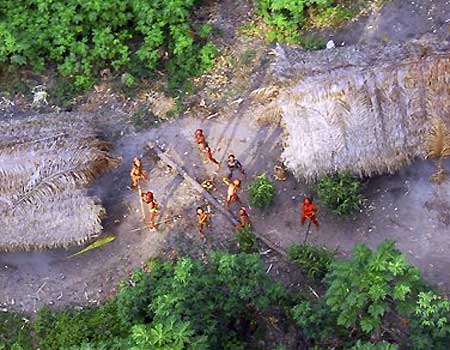
May 30, 2008
Before you jump to any conclusions, remember “hominoids” includes humans, hominids, anthropoids, and pongids.
What has been discovered, actually?
What would happen if an undiscovered group of so-called “Brazilian Indians” was found, and among them were seen “near-humans”? Would anyone take the possibilities seriously?
In a time when Google Earth is spotting hidden huts in the jungles, will satellite photos reveal more than living areas and humans? Will sky-based photography point out more of a diversity of hominoids or merely confuse the picture?
See today’s breaking images from Brazil:




Fox News is reporting on Friday, May 30, 2008, those photos and the following, regarding the source of the images:
One of Brazil’s last uncontacted Indian tribes has been spotted in the far western Amazon jungle near the Peruvian border, the National Indian Foundation said Thursday.
The Indians were sighted in an Ethno-Environmental Protected Area along the Envira River in flights over remote Acre state, said the Brazilian government foundation, known as Funai.
Funai said it photographed “strong and healthy” warriors, six huts and a large planted area. But it was not known to which tribe they belonged, the group said.
“Four distinct isolated peoples exist in this region, whom we have accompanied for 20 years,” Funai expert Jose Carlos Meirelles Junior said in a statement.
The tribe sighted recently is one of the last not to be contacted by officials. Funai does not make contact with such Indian tribes and prevents invasions of their land to ensure their autonomy, the foundation said.
Survival International said the Indians are in danger from illegal logging in Peru, which is driving tribes over the border and could lead to conflict with the estimated 500 uncontacted Indians now living on the Brazilian side.
There are more than 100 uncontacted tribes worldwide, most of them in Brazil and Peru, the group said in a statement.
“These pictures are further evidence that uncontacted tribes really do exist,” Survival director Stephen Corry said.
“The world needs to wake up to this, and ensure that their territory is protected in accordance with international law. Otherwise, they will soon be made extinct.”

Cryptomundo correspondent “dvdw” writes: “One of the creatures shown does not look human.”
Frankly, I think we have to tread carefully here, as diversity of skin color, body paint, and hair ornaments can be viewed strangely from hundreds of feet above.
Humans do have an amazing ability to make themselves look differently to each other, and especially to members of the opposite gender.
What do you think?
About Loren Coleman
Loren Coleman is one of the world’s leading cryptozoologists, some say “the” leading living cryptozoologist. Certainly, he is acknowledged as the current living American researcher and writer who has most popularized cryptozoology in the late 20th and early 21st centuries.
Starting his fieldwork and investigations in 1960, after traveling and trekking extensively in pursuit of cryptozoological mysteries, Coleman began writing to share his experiences in 1969. An honorary member of Ivan T. Sanderson’s Society for the Investigation of the Unexplained in the 1970s, Coleman has been bestowed with similar honorary memberships of the North Idaho College Cryptozoology Club in 1983, and in subsequent years, that of the British Columbia Scientific Cryptozoology Club, CryptoSafari International, and other international organizations. He was also a Life Member and Benefactor of the International Society of Cryptozoology (now-defunct).
Loren Coleman’s daily blog, as a member of the Cryptomundo Team, served as an ongoing avenue of communication for the ever-growing body of cryptozoo news from 2005 through 2013. He returned as an infrequent contributor beginning Halloween week of 2015.
Coleman is the founder in 2003, and current director of the International Cryptozoology Museum in Portland, Maine.
Filed under Breaking News, Cryptotourism, CryptoZoo News, Cryptozoologists, Cryptozoology, Evidence, Expedition Reports, Mapinguary, Photos, Proto-Pygmies